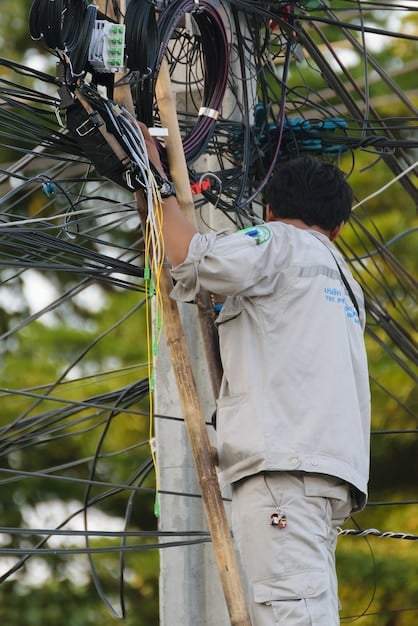Infrastructure Act’s Impact on Rural US Wireless Broadband

The Infrastructure Investment and Jobs Act is poised to significantly impact US rural wireless broadband by allocating substantial funding for infrastructure development, aiming to bridge the digital divide and enhance connectivity in underserved areas.
The Impact of the Infrastructure Investment and Jobs Act on US Rural Wireless Broadband promises a transformative shift in connectivity, particularly for underserved communities. This legislative push aims to bridge the digital divide, fostering economic growth and improving quality of life through enhanced wireless infrastructure.
Understanding the Infrastructure Investment and Jobs Act
The Infrastructure Investment and Jobs Act, often referred to as the Bipartisan Infrastructure Law, represents a historic investment in America’s infrastructure. It addresses various sectors, including transportation, water, energy, and broadband internet access. The act’s focus on broadband is particularly significant for rural areas, which have historically lagged in connectivity.
Key Provisions for Broadband
Several key provisions within the act are specifically aimed at expanding broadband access. These include funding for infrastructure deployment, affordability programs, and digital equity initiatives. The goal is not only to build the necessary infrastructure but also to ensure that internet access is affordable and accessible to all residents.
- Funding for Broadband Infrastructure Deployment
- Affordability Programs to Reduce Costs for Low-Income Households
- Digital Equity Initiatives to Promote Digital Literacy and Inclusion
These provisions collectively aim to address the multi-faceted challenges of bridging the digital divide. By investing in infrastructure, affordability, and digital literacy, the act seeks to create a more equitable and connected society.

The successful implementation of these provisions will depend on effective coordination among federal, state, and local stakeholders. Collaboration between government agencies, internet service providers, and community organizations will be crucial to ensure that resources are deployed efficiently and effectively.
The Digital Divide in Rural America
The digital divide refers to the gap between those who have access to modern information and communication technologies and those who do not. In the United States, this divide is particularly pronounced in rural areas, where access to reliable and affordable broadband internet is often limited.
Challenges of Rural Broadband Deployment
Several factors contribute to the challenges of deploying broadband in rural areas. These include low population density, difficult terrain, and high infrastructure costs. These challenges make it less economically attractive for private companies to invest in rural broadband infrastructure.
The lack of adequate broadband infrastructure in rural areas has significant consequences for economic development, education, healthcare, and civic engagement. Without reliable internet access, rural communities are at a disadvantage in an increasingly digital world. Remote work, online education, and telehealth services are all reliant on robust broadband connections, making it difficult for rural residents to participate fully in these activities.
- Low Population Density Increases Infrastructure Costs
- Difficult Terrain Complicates Deployment Efforts
- Limited Economic Incentives for Private Investment
The digital divide also has implications for social equity. Low-income households and marginalized communities are disproportionately affected by the lack of broadband access. Addressing the digital divide is therefore not only an economic imperative but also a matter of social justice.
Bridging the digital divide requires a comprehensive approach that addresses both the supply and demand sides of the equation. This includes investing in infrastructure, promoting affordability, and increasing digital literacy. The Infrastructure Investment and Jobs Act represents a significant step in this direction, but sustained efforts are needed to ensure that all Americans have access to the benefits of broadband.
Funding Allocation for Rural Wireless Broadband
A significant portion of the Infrastructure Investment and Jobs Act is dedicated to funding broadband infrastructure projects. This funding is allocated through various programs and initiatives, each with its own specific goals and requirements. Understanding how this funding is allocated is crucial for ensuring that it is used effectively to expand rural wireless broadband.
Specific Programs and Initiatives
One of the key programs is the Broadband Equity, Access, and Deployment (BEAD) Program, which provides funding to states for broadband infrastructure deployment. The BEAD Program prioritizes projects that serve unserved and underserved areas, with a focus on deploying high-speed, reliable internet access.
The act also includes funding for the ReConnect Program, which provides loans and grants to expand broadband access in rural areas. The ReConnect Program targets projects that can deliver speeds of at least 100 Mbps download and 20 Mbps upload, ensuring that rural communities have access to modern internet services.
- Broadband Equity, Access, and Deployment (BEAD) Program
- ReConnect Program
- Digital Equity Act Programs
In addition to these programs, the act includes funding for digital equity initiatives, which aim to promote digital literacy and inclusion. These initiatives provide training and resources to help people develop the skills they need to use the internet effectively.
The allocation of funding for rural wireless broadband is overseen by various federal agencies, including the National Telecommunications and Information Administration (NTIA) and the Federal Communications Commission (FCC). These agencies work together to ensure that funding is distributed fairly and efficiently, and that projects are aligned with national broadband goals.

The impact of this funding allocation will depend on how effectively it is used to address the specific challenges of rural broadband deployment. This includes overcoming technical hurdles, coordinating with local stakeholders, and ensuring that projects are sustainable in the long term.
Technological Advancements in Wireless Broadband
Wireless broadband technology has advanced rapidly in recent years, offering new opportunities for expanding internet access in rural areas. These advancements include improvements in network capacity, coverage, and efficiency, making wireless solutions more viable for serving remote and sparsely populated regions.
5G and Next-Generation Technologies
One of the most significant advancements is the deployment of 5G technology, which offers significantly faster speeds and lower latency compared to previous generations of wireless. 5G networks can support a wide range of applications, including streaming video, online gaming, and remote work, making them well-suited for serving the needs of rural communities.
Another important development is the use of fixed wireless access (FWA), which provides broadband internet access using wireless signals transmitted from a base station to a receiver at the customer’s premises. FWA is particularly well-suited for rural areas, where it can be deployed more quickly and cost-effectively than traditional wired broadband technologies.
Advancements in satellite technology are also playing a role in expanding rural broadband access. Low Earth Orbit (LEO) satellites offer lower latency and higher speeds compared to traditional geostationary satellites, making them a viable option for providing internet access in remote areas.
- 5G Technology
- Fixed Wireless Access (FWA)
- Low Earth Orbit (LEO) Satellites
These technological advancements are driving down the cost of deploying wireless broadband infrastructure and making it more feasible to serve rural communities. However, challenges remain in terms of spectrum availability, network security, and ensuring that wireless networks are resilient and reliable.
The successful adoption of these technologies will require collaboration between government, industry, and academia. This includes developing standards, conducting research, and providing training to support the deployment and maintenance of wireless broadband networks in rural areas.
Economic and Social Impact on Rural Communities
Expanding rural wireless broadband access has the potential to generate significant economic and social benefits for rural communities. These benefits include increased economic activity, improved access to education and healthcare, and enhanced civic engagement. By bridging the digital divide, rural communities can unlock new opportunities for growth and development.
Economic Growth and Job Creation
Access to reliable broadband internet can spur economic growth in rural areas by enabling businesses to reach new markets, improve efficiency, and adopt new technologies. Remote work opportunities can also expand, allowing rural residents to work for companies located anywhere in the world.
Broadband access can also support entrepreneurship and small business development in rural areas. With access to online resources and markets, rural entrepreneurs can start and grow businesses, creating jobs and boosting local economies.
In addition to economic benefits, broadband access can improve access to education and healthcare in rural areas. Online learning platforms can provide access to a wider range of courses and educational resources, while telehealth services can improve access to medical care for rural residents.
- Increased Economic Activity
- Improved Access to Education and Healthcare
- Enhanced Civic Engagement
Broadband access can also enhance civic engagement by enabling residents to participate in online forums, access government services, and stay informed about local and national issues. This can lead to a more engaged and informed citizenry.
Realizing these economic and social benefits requires a holistic approach that addresses both the supply and demand sides of the equation. This includes not only building the necessary infrastructure but also ensuring that residents have the skills and resources they need to use the internet effectively.
Challenges and Opportunities for Implementation
While the Infrastructure Investment and Jobs Act offers significant opportunities for expanding rural wireless broadband access, there are also challenges that must be addressed to ensure successful implementation. These challenges include regulatory hurdles, workforce shortages, and cybersecurity threats. Overcoming these challenges will require collaboration between government, industry, and community stakeholders.
Regulatory Hurdles and Workforce Shortages
One of the key challenges is navigating the complex regulatory landscape surrounding broadband deployment. Permitting delays, environmental regulations, and other regulatory hurdles can slow down the deployment process and increase costs. Streamlining these processes is essential for accelerating the expansion of rural wireless broadband.
Another challenge is addressing the workforce shortages in the telecommunications industry. There is a growing need for skilled technicians, engineers, and other professionals to build, maintain, and operate wireless broadband networks. Investing in training and education programs is crucial for addressing this workforce gap.
Cybersecurity threats also pose a significant challenge to the deployment of rural wireless broadband. Wireless networks are vulnerable to cyberattacks, which can disrupt service, compromise data, and undermine trust. Implementing robust cybersecurity measures is essential for protecting rural wireless broadband networks.
- Regulatory Hurdles
- Workforce Shortages
- Cybersecurity Threats
Despite these challenges, there are also significant opportunities for innovation and collaboration. By working together, government, industry, and community stakeholders can overcome these challenges and build a more connected and prosperous rural America.
The key to successful implementation is to adopt a flexible and adaptive approach that takes into account the unique needs and circumstances of each rural community. This includes tailoring solutions to local conditions, engaging local stakeholders, and fostering innovation.
| Key Aspect | Brief Description |
|---|---|
| 💰 Funding Boost | Bill allocates significant funds to expand broadband infrastructure in rural areas. |
| 🌐 Digital Divide | Aims to bridge the gap between urban and rural access to broadband services. |
| 🚀 Tech Advances | Promotes the use of 5G and other advanced technologies for wireless broadband. |
| 🧑🌾 Community Impact | Intended to boost rural economies and provide better access to services like education and healthcare. |
Frequently Asked Questions
▼
The Infrastructure Investment and Jobs Act allocates approximately $65 billion to expand broadband access across the US, with a significant portion targeted for rural areas.
▼
The Broadband Equity, Access, and Deployment (BEAD) Program provides funding to states for broadband infrastructure deployment, prioritizing unserved and underserved locations.
▼
The act includes affordability programs to reduce internet costs for low-income households, ensuring that access is not only available but also affordable.
▼
The act promotes the deployment of 5G, fixed wireless access (FWA), and low Earth orbit (LEO) satellites to improve rural wireless broadband connectivity.
▼
By improving broadband access, the act aims to spur economic growth in rural areas, enabling businesses to expand and providing residents with better access to remote work opportunities.
Conclusion
The Infrastructure Investment and Jobs Act represents a pivotal moment for US rural wireless broadband, with the potential to transform connectivity and opportunity in underserved communities. By addressing the challenges of infrastructure deployment, affordability, and digital literacy, the act paves the way for a more equitable and prosperous future for rural America.





